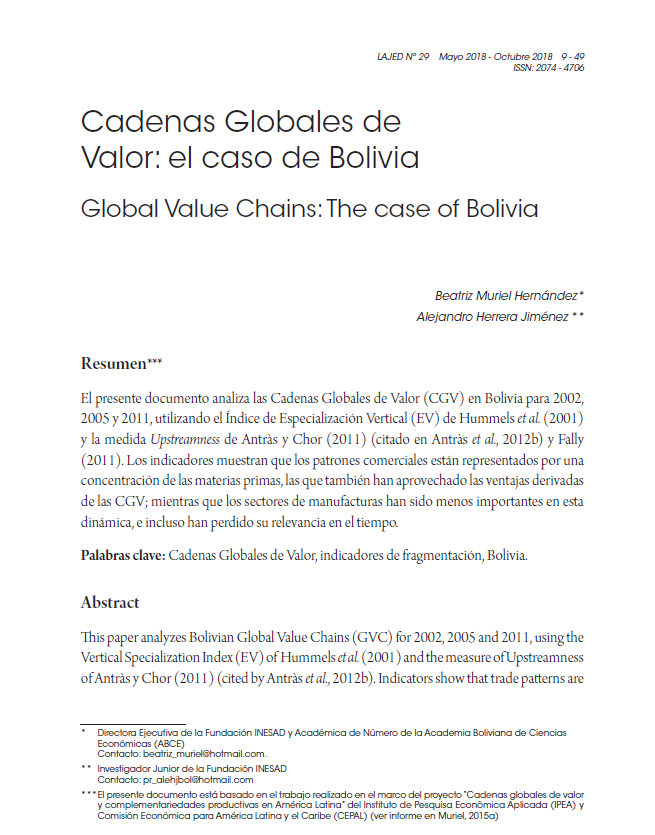Global Value Chains: The case of Bolivia
DOI:
https://doi.org/10.35319/lajed.20182918Keywords:
Global Value Chains, fragmentation indicators, BoliviaAbstract
This paper analyzes Bolivian Global Value Chains (GVC) for 2002, 2005 and 2011, using the Vertical Specialization Index (EV) of Hummels et al. (2001) and the measure of Upstreamness of Antras y Chor (2011) (cited by Antras et al., 2012b). Indicators show that trade patterns are represented by a concentration of raw materials, which have also taken advantage from those derived from GVC; while manufacturing sectors have been less important in this dynamic, and they even lost their relevance over time.
Downloads
References
Antràs, P. y D. Chor. 2013. “Organizing the Global Value Chain”. Econometrica 81(6): 2127-2204.
Antràs, P., D. Chor, T. Fally y R. Hillberry. 2012a. “Measuring the Upstreamness of Production and Trade Flows”. Documento de trabajo 17819. National Bureau of Economic Research. Cambrigde.
---------- 2012b. “Measuring the Upstreamness of Production and Trade Flows”. American Economic Review, 102(3): 412-416.
Amador J. y S. Cabral. 2009. “Vertical Specialization Across the World: A Relative Measure”. North American Journal of Economics and Finance, 20: 267-280.
Amador, J. y S. Cabral. 2014. “Global Value Chains: A Survey of Drivers and Measures”. Journal of Economic Surveys, 30 (2): 278-301.
Bems, R., R. C. Johnson y K. Yi 2011. “Vertical Linkages and the Collapse of Global Trade”. American Economic Review: Papers and Proceedings, 101(3): 308-312.
Chen, B. 2017. “Upstreamness, Exports, and Wage Inequality: Evidence from Chinese Manufacturing Data”. Journal of Asian Economics, 48: 66-74.
Confederación de Empresarios Privados de Bolivia. 2009. “Comercio exterior Ilegal en Bolivia, Estimaciones 2000-2008”. Manuscrito no publicado. La Paz, Bolivia.
Dean, M. J., K. C. Fung, y Z. Wang. 2011. “Measuring Vertical Specialization: The Case of China”. Review of International Economics, 19(4): 609–625.
De Backer, K. y S. Miroudot. 2014. “Mapping Global Value Chains”. Documento de trabajo No 1667. European Central Bank. Frankfurt, Germany.
Durán, L. J. y D. Zaclicever (2013). “América Latina y el Caribe en las cadenas internacionales de valor”. Serie Comercio Internacional. Comisión Económica para América Latina y el Caribe y Agencia Española de Cooperación Internacional para el Desarrollo. Santiago, Chile.
Fally T. 2011. “On the Fragmentation of Production in the U.S.” Manuscrito no publicado. Universidad de Colorado-Boulder.
Hagemejer, J. y J. Tyrowicz. 2017. “Upstreamness of employment and global financial crisis in Poland: the role of position in the global value chains”. GRAPE Documento de trabajo No 15. Foundation of Admirers and Mavens of Economics, Group for Research in Applied Economics. Poland.
Hummels, D., J. Ishii y K. Yi. 2001. “The Nature and Growth of Vertical Specialization in World Trade”. Journal of International Economics, 54: 75-96.
Instituto Nacional de Estadística. 1992. Nueva base de las cuentas nacionales de Bolivia: métodos y resultados 1988. La Paz.
---------- 1996. Cuentas nacionales 1988-1992. La Paz.
---------- 2004. Metadato de cuentas nacionales: metodología insumo-producto. Disponible en: http://www.ine.gob.bo/pdf/Metodologias2004/MetadatosCtasNalesInsumoProducto.doc.
Ito, T. y P. Vézina. 2016. “Production Fragmentation, Upstreamness, and Value Added: Evidence from Factory Asia 1990-2005”. Journal of The Japanese and International Economies, 42: 1-9.
Muriel H., B. 2004. Três Ensaios sobre as Predições de Heckscher-Ohlin: Questões Teóricas e Testes Empíricos. Tesis de Doctorado en Economía. Departamento de Economía, Pontificia Universidade Católica do Rio de Janeiro. Rio de Janeiro, Brasil.
---------- 2015a. “Cadenas globales de valor y complementariedad productiva en América del Sur: Informe Bolivia”. Manuscrito no publicado. Instituto de Pesquisa Econômica Aplicada (IPEA) y Comisión Económica para América Latina y el Caribe (CEPAL).
---------- 2015b. “Contexto macroeconómico e ingresos laborales”. Umbrales, 28: 67-98.
Naciones Unidas. 2003. “Clasificación por grandes categorías económicas”. Departamento de Asuntos Económicos y Sociales. Serie de Documentos Estadísticos N° 53. Nueva York, Estados Unidos.
Nordas, H. 2008. “Vertical Specialisation and its Determinants”. Journal of Development Studies, 44(7):1037-1055.
Norén, R. 2010. “Globalisation and the Intermediate Structure: A Study of Swedish Manufacturing 2000 and 2005”. Journal of Policy Modeling , 32:223–230.
Rodrigues, F. W. y V. C. Lazarini. 2015. “Cadeias globais de valor e complementaridade produtiva na América do Sul: relatório final”. Manuscrito no publicado. Instituto de Pesquisa Econômica Aplicada. Brasilia, Brasil.






